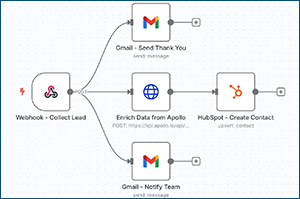
Breaking into a new B2B market used to feel ambitious and mildly terrifying — weeks of research, Excel gymnastics, and a lot of coffee. Today? Not so dramatic. AI and automation take care of the grunt work, leaving you time for what actually matters: strategy and human-to-human outreach.
Below: a step-by-step playbook (with short, real-feeling examples) that shows how the process changed — and how you can apply it right away.
1. Using AI to Map Niches and Match Ideal Buyers
Old way: Google lists, trade show participant spreadsheets, Yellow Pages, LinkedIn — the kind of manual digging that eats a week and your patience.
Now: prompt Perplexity for market maps and micro-niches, pull the linked sources, and export lists into Google Sheets via simple automation (Google Sheets with app script, N8N, python...?). The same intel — in hours, not days.
2. Relevancy scoring — cut the noise
Finding companies is one thing. Finding the right companies is another.
- Old: Python scrapers looking for keywords like
JavaorHIPAA. - Now: AI microservices scan sites, reports, news, job boards and other public pages, outputting a relevancy score (e.g. 9/10 — legacy .NET, very relevant) and a short explanation.
3. Finding decision-makers — less digging, more connecting
Companies are fine — but who signs the check?
- Old: LinkedIn Sales Navigator + CrunchBase + paid databases (and a growing subscription bill).
- Now: microservices + aggregator APIs (Apify, targeted agents) that pull likely decision maker profiles from public sources; if gaps remain, selectively use pay-as-you-go services.
4. Purchase readiness — signals that actually mean something
“This company fits” is not the same as “this company is buying now.” Look for signals:
- Job postings (they are hiring employees to solve a problem that you have already learned to solve for dozens of clients).
- News (investment rounds = budget, layoffs = pause).
- Tender portals, regional announcements, industry forums and even Reddit threads.
5. Outreach & communications — human first, automated second
With the right list, you can stop blasting and start starting conversations.
- Old: emails to segments with spintax like
{Hello|Hi|Hey} or I wanted to {reach out|connect|get in touch} about…. - Now: AI crafts personalized outreach using the dossier you’ve built — tailored messages for each role/context, then automation sends them from warmed email inboxes and active LinkedIn accounts.
Quick note: personalization isn’t inserting a name — it’s demonstrating context awareness (they raised funds, they’re opening a new hub, they mentioned a challenge in an article). That’s what warms a lead.
From manual research to a LEGO-like system
Market entry isn’t a minefield anymore — it’s a LEGO set: pick the microservices, plug in AI and automation, and build a repeatable system.
- Research time drops from days to hours.
- Irrelevant companies get filtered automatically.
- Decision makers surface faster.
- Purchase readiness is verified by real signals.
- Communications become personalized and alive.
Heads up: two years ago we were still doing the digging for clients by hand. Today we do that digging and we set up the tools — then hand those tools to the client.
No subscriptions. No vendor lock-in. We generate MQLs for you while building the system that stays with you.
Interested? We also maintain a set of free microservices you can try.